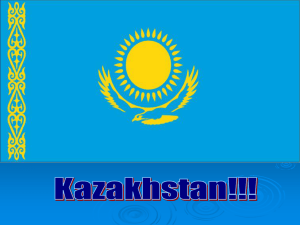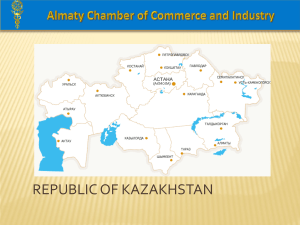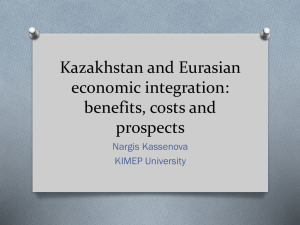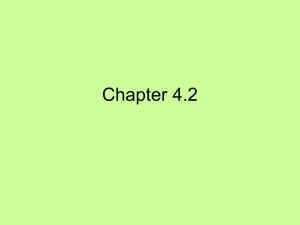**** 1
advertisement
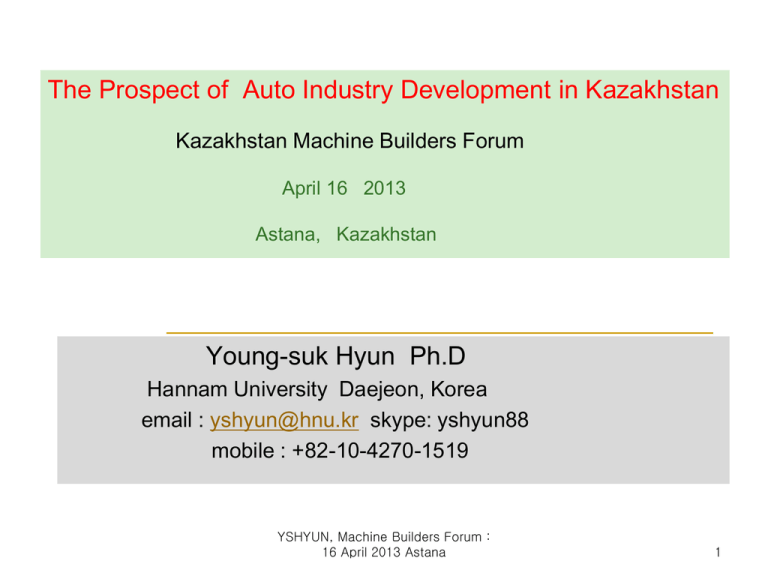
The Prospect of Auto Industry Development in Kazakhstan Kazakhstan Machine Builders Forum April 16 2013 Astana, Kazakhstan Young-suk Hyun Ph.D Hannam University Daejeon, Korea email : yshyun@hnu.kr skype: yshyun88 mobile : +82-10-4270-1519 YSHYUN, Machine Builders Forum : 16 April 2013 Astana 1 The Prospect of Auto Industry Development in Kazakhstan I. Introduction II. Demand Forecast of Kazakhstan Auto Industry III. Auto Industry Policy Options and Lessons IV. Policy of Kazakhstan Auto Industry V. Discussions YSHYUN, Machine Builders Forum : 16 April 2013 Astana 2 I Introduction Outside CIS (China, EU) CIS (Uzbekistan, Ukr… ) CU Russia Belarus Kazakhstan YSHYUN, Machine Builders Forum : 16 April 2013 Astana 3 West and East Bound Move to Kazakhstan Russia 2.0 million prod (2011) Customs Union 2010 - Gov. Strategy 2020 for Russian Car Industry - Industrial Assembly Agreement East Bound Move Kazakhstan 9,550 prod (2011) Risk of Nutcracker China West Bound Move 18.4 million prod (2011) WTO 2013 (KZ) Cheap Price Largest producer & market M&A Long-term Auto Industry Dev. Plan YSHYUN, Machine Builders Forum : 16 April 2013 Astana 4 Strategic Path and Natural Path Value Added, Job Creation, Industrialization Large small River Strategic path Natural path Ship YSHYUN, Machine Builders Forum : 16 April 2013 Astana 5 □ Kazakhstan’s Access to the WTO Kazakhstan’s accession to the WTO will become one of the most important stages on the way to integration of the country into the global economic system. But under the Customs Union regime, Kazakhstan cannot but follow Russia’s market opening schedule in negotiation with WTO. It will lower common customs tariffs and boost import demand. □ Impact and Policy Implication Lower Tariff Lower Price of Foreign Automobile Foreign Autos get More Competitive Power Gain More Kazakhstan’s Auto Market Domestic Car Makers are difficult to survive YSHYUN, Machine Builders Forum : 16 April 2013 Astana 6 II. Demand Forecast of Kazakhstan Auto Industry Assumption of Vehicle Demand Forecast in Kazakhstan High Growth More than 6% Middle Growth 5%~6% Expand until 2020 Expand until 2016 and s Expand until 2016 lowdown Strategy of Auto company Aggressive medium Less aggressive Energy Price Lower Stable Higher Government Support Strong Weak No Annual GDP Growth rate Road Infrastructure Low Growth Less than 5% Aggressive Mid Growth High Growth No Growth Low Growth Company Strategy Less Aggressive Weak Government Support YSHYUN, Machine Builders Forum : 16 April 2013 Astana Strong 7 Summary of KZ’s Vehicle Demand Forecast in 2020 (Units) High Growth New Vehicle Mid Growth Low Growth 395,000 248,457 192,000 300,000 168,447 130,000 bus 20,000 16,010 12,400 truck 75,000 64,000 49,600 Used Vehicle 125,000 62,500 48,000 Total Demand 520,000 310,957 240,000 passenger car Summary of Three Growth Scenarios in 2020 2011 2012 Total New Vehicle Demand 63,607 130,000 New Vehicle Import (import ratio) 55,000 110,000 1,229 8,000 1,000 20,000 Export Local production Reference Case 2020 Optimistic 395,000 Neutral 248,457 Pessimistic 192,000 158,000 (40%) 70,000 307,000 124,227 (50%) 50,000 173,728 115,200 (60%) 30,000 106,800 Romania Vietnam Korea, Uzbekistan Iran(IKCO) YSHYUN, Machine Builders Forum : 16 April 2013 Astana 8 III Auto Industry Policy Options and Lessons YSHYUN, Machine Builders Forum : 16 April 2013 Astana 9 Malay sia China Russia Thailand Brazil Slovakia Uzbekistan Korea WTO 1995 2001 2012 1995 1995 1995 no 1995 Firms Local MNC MNC(state JV) Local MNC Local MNC MNC MNC State JV Local MNC Total 27 CV 9 Local 2 proton, Perodua 25 Local Geely, Chery, BYD 25 Car 17 CV 8 Local GAZ,Kama z,,,, 15 Japan EU, China 19 US, EU Japan 3 car only France, Korea Germany 1 Uz-GM 7 Car 5 CV 2 Local : Hyundai Kia Major Produc ts local MNC MNC Local local MNC MNC MNC MNC MNC Local MNC Policy (WTO after) Product tax Local content Local content Recycling tax Japanese production hub MNC dependent Export to EU Import prohibit NO WTO Special Consumpti on Tax Automobile tax Recycling tax Local content product tax (VAT) Remark s Self reliance Large domestic demand Large potential demand Large population Large population EU CIS Gov Initiative Gov. 1970s Prod 2011 Car 488,261 CV 45,254 Car 14,472,416 CV 4,032,698 Car 1,738,163 CV 250,757 Car 537,987 CV 919,808 Car 2,519,389 CV 1,013,227 Car: 640,230 only Car 222,022 only Car 4,221,617 CV 435,477 2020 Plan (2010) YSHYUN, Machine Builders Forum : 16 April 2013 Astana Kazakhsta n 2013 Local MNC 7,000 10 WTO and Gov Auto Industry Policy Policy WTO Access 1.MNC admit and local Early 1995 model dev WTO early MNC admit and Local dev WTO late Late more late Country After WTO WTO, remarks Malaysia -local content -product tax protest China Dec. 2001 Russia Aug. 2012 -local content protest -recycling tax protest 3. MNC admit and no local model Early 1995 Thailand, Brazil Slovakia - no violate 4. MNC admit And no local model NO WTO No Uzbekistan -Import prohibit -export promotion NA 5. MNC admit But Strong Self Reliant Early 1995 Korea -special consumption tax (purchase) -automobile tax (operating) R&D, education, business, tech support YSHYUN, Machine Builders Forum : 16 April 2013 Astana 11 Establish Long-term Development Plan □ Korean government has supported holistically for the automotive industry. - Government’s support is important to cross the chasm. Performance Korea Mainstream Leaf frog chasm (Death Valley) Developing countries Fall Behind Chaos (Market Opening) Time Infant Growth Mature 12 Lessons from Korea’s Experience WTO Local Brand 1. Korea : 10th auto producing country (2.52 mil. production, export 978 thousands in 1995 when accessing WTO 2. Government strong initiative in supply and demand policy to dev local model in 1970s by local firm Hyundai Motor 3. Before WTO Korea, Gov could implement every policies to support local model and local maker : (ref: KOICA Report to Kazakhstan Gov. Feb. 2010) 4. Hyundai Motor selected “self reliance strategy” to develop local model with high risk taking entrepreneurship. 5. Korean Gov 1) special consumption tax (purchase tax : product Tax) 2) automobile tax (operating tax) to regulate foreign car import - heavy tax for large cars (most import car) after WTO 3) Emission regulation as to regulate import of large foreign car abolished as of the FTA with USA in 2012 8. Lessons - strong gov. intervention : industry policy, local content, local model dev - without local model, hard to increase local content - but it was experience in 1970, 1980s before WTO 13 - rapid catch up strategy under GATT China after WTO (Dec 11 2001) 1) Import Quota ; 1986-2005 (20 years) even after WTO Dec 11 2001 2) Local Content Issues 1 : WTO 2001 over 60% foreign parts vehicle assembled in China (below 40 local content vehicle) import duty (Custom tax) is same as complete vehicle 25% 2006 EU, USA proclaim to WTO as Unfair Trade 2008 China defeated but protest again to prevent simple screw drive foreign vehicle plant in China 2009 Abolish 3) Local Content Issues 2: by 2005 some parts custom duty 30% ( other parts 13-17%) 2006 to comply WTO complete vehicle 25% parts : 10% 4) Local Brand Vehicle Target (2006) 40% (2005) 60% (2010) 5) regulate foreign investment 2001-2008 limit not over 50% of foreign investment in automobile industry not parts ind. 6) Vehicle Safety Regulation (2005) : 9 regulations (back mirror, door lock, interior materials … 7) Minimum Export Ratio Policy (2006) : new auto plant must meet Min export Ratio YSHYUN, Machine Builders Forum : 16 April 2013 Astana 14 IV. Policy of Kazakhstan Auto Industry Extensive inter-industry relationships <Figure > Unit Structure of Korean Automobile Industry (2000) Auto Industry Steel 70 Machinery Rubber & plastic 60 50 Electronics Chemical 40 1 .농 림 수 산 품 3 .음 식 료 품 5 .목 재 및 종 이 제 품 7 .석 유 석 탄 제 품 9 .고 무 및 플 라 스 틱 1 1 .철 강 1 3 .금 속 제 품 1 5 .전 기 전 자 기 기 1 7 .자 동 차 1 9 .기 타 수 송 장 비 2 1 .전 력 가 스 수 도 2 3 .도 소 매 2 5 .운 수 및 보 관 2 7 .금 융 및 보 험 2 9 .사 업 서 비 스 3 1 .교 육 및 연 구 3 3 .문 화 오 락 서 비 스 3 5 .기 타 30 20 10 35. 기타 34. 기타서비스 32. 의료 및 보건 33. 문화오락서비스 및 국방 31. 교육 및 연구 30. 공공행정 28. 부동산 29. 사업서비스 26. 통신 및 방송 27. 금융 및 보험 24. 음식 및 숙박 25. 운수 및 보관 22. 건설 23. 도소매 21. 전력가스수도 20. 기타제조업제품 18. 선박 19. 기타수송장비 17. 자동차 16. 정밀기기 15. 전기전자기기 13. 금속제품 14. 일반기계 11. 철강 12. 비철금속 10. 비금속광물제품 8. 화학제품 9. 고무 및 플라스틱 6. 인쇄 및 출판 7. 석유석탄제품 4. 섬유제품 5. 목재 및 종이제품 2. 광산품 3. 음식료품 1. 농림수산품 0 Source : Input-Output Table, Bank of Korea YSHYUN, Machine Builders Forum : 16 April 2013 Astana 15 Industrialization Kazakhstan Basic Strategy in Automobileof and Automotive Parts Industry ⊙ Basic Approach Autom obile Supply Demand Machinery Vehicle Driver : MES 20,000- 50,000 After market Parts Demand Creation Investment (Foreign/Local) Auto Industry for auto plant for parts Industry Parts Industry for after market Kazakhstan CU CIS Kazakhstan Machinery Parts Industry Manufacturing Industry Industrialization of Kazakhstan MES : Minimum Economic Scale YSHYUN, Machine Builders Forum : 16 April 2013 Astana 16 Policy Options of Kazakhstan Auto Industry 1 2 Strategy Country Local Market protect Gov. role Remarks MNC Invest Local Model WTO access protest Malaysia Chinese Russian -Recycling tax -Product tax -Local content Gov: Local model Support Policy Many MNC firms MNC Invest No Local Model WTO access and Follow Thailand Brazil Slovakia -Dependent on MNC How to meet Russia, China Uzbekistan Thailand : Japanese production hub Local firms Custom Union 1. Strategic path : Government Strong support 2 Natural path : Government Weak support YSHYUN, Machine Builders Forum : 16 April 2013 Astana 17 Two Paths : Malaysia vs Thailand Malaysia Thailand Basic Policy Self reliance, Look East Policy in 1980s dependent WTO Access 1995 1995 ASEAN ASEAN Member ASEAN Member Auto Maker Local Maker. Model 27 Local Maker: Proton. Perodua Local Model : Proton, 15 No Local maker No Local model : Toyota, Isuzu, Honda Nissan . Mitsubishi Gov Policy 2009 New Auto Industry Policy Incentive for local brand 2007 Eco car Program Incentive for foreigner Investment in auto industry Local Model Share 60% + 0% Japanese model 90% WTO Against Follow Key Role Man Mr. Mahatier (Advisor Proton) Previous Prime Minister 2011 Production 2011 Export 1,193,000 units Remarks Lead Indonesia to start Timor Project in mid 1990s but fail as of WTO dispute ( major : car ) 1,457,795 units (major : pick-up) 733,950 2012 : 10th auto making country Pick-up Export Base 18 Malaysian path 1. Gov Policy : strong gov. support for local maker, local model in 1980s “Proton” to follow Korean Hyundai Path in 1970s [Look East Policy] 2. Technical Assistance from Mitsubishi Motor/Japan 1995 60 % local Brand ( Proton, Perodua) 3 Product Tax 2004 1.1 Auto Parts custom tax decrease for ASEAN countries Product Tax Increase for imported vehicle, local vehicle assembled by foreign makers Product Tax is internal tax not WTO issues but national interest 4. Strong Man PM : Dr. Mahatier “Hereafter 20 years, Malaysia needs protection policy for local model car 4. Against and argue WTO : 2009 10 Industry Policy Used car Import prohibited/ 50% reduction of consumption tax for local model /Old car support to buy local model 5. Free trade in 2006 : ten year after WTO 6. ASEAN member in competing Thailand’s parts industry Japanese support 7. Motivate Indonesia to start national car “Timor Project” in mid 1990s Indonesia : Low local content / dependent on MNC Japanese makers Screw drive factory YSHYUN, Machine Builders Forum : 16 April 2013 Astana 19 Thailand Path 1. Gov Policy : weak support , no local maker , no local model 2. Japanese production hub for ASEAN countries production 90% Japanese Brand 4. 2007 Eco car program below 1300cc gasoline 1400 cc diesel car 500 Million Baht Invest 100,000/ year within 5 year, engine, core parts in Thailand product tax 30% discount -> no corporate tax for 8 years -> no Tariff for Machine and facility for auto plant induce : Honda, Susuki, Nissan, Mitsubishi, Toyota 4. Relatively strong parts industry by Japanese makers 5. ASEAN member in competing Malaysia 6. 0th auto making country in 201 2 YSHYUN, Machine Builders Forum : 16 April 2013 Astana 20 CU and WTO to Kazakhstan’s Automobile Industry Free Trade Major Policy Weapons and Strategy to KZ Influence on Kazakhstan’s auto Indus try (new vehicle Import portion, Data: Custom Office Kz) 2010 Custom Russia Union (CU) -East Bound Move Car 2011 Car -Russia’s 2020 Plan/Govern Truck 46.4 % Truck 50% ment support Bus 21.6% Bus 59.6 % -Foreign alliance WTO China -West bound Move Car Car -Cheap Price Truck 29.6% Truck 32.8% -World factory (largest produ Bus 9.3 Bus 8.2 cer, largest market) YSHYUN, Machine Builders Forum : 16 April 2013 Astana 21 Competitors Analysis of Kazakhstan Automotive Industry Specification Competition Current competitor Potential competitor Source of Compe titive Strength Car - 1500cc Uzbekistan China Low price Uz-Daewoo 1500-1800cc Russia Lada Russia, China Korea 1800-3000 Japan, Toyota Japan, German Quality, Brand Korea Over 3000 Japan, Toyota Japan, German Russia Russia, China 5 ton Russia Russia, China 5-20 ton Russia Russia, China Over 20 ton China China Special China China Vehicle* Belarus Bus Truck - Quality, Brand 22 Forecast 1. Russia -Renault allied with AvtoVaz will export vehicles to Kazakhstan unless Kazakhstan can not develop her own automobile industry. - Kazakhstan could impose ‘recycling tax’. But that will be hindrance to Kazakhstan’s automobile export. Governments of vehicle export countries will retaliate on vehicles produced in Kazakhstan (ex: China) - How Meet Foreign and Russian vehicles made in Russia exported to Kazakhstan 2. China China will build auto plant in Belarus, Russia and Kazakhstan to use CU and WTO : Commercial Vehicle, car 3. Uzbekistan : small car export or assembly in KZ 4. EU : car assembly plant in Kazakhstan 5. Asia : Korea, Japan : car and commercial vehicle (Bus Truck) YSHYUN, Machine Builders Forum : 16 April 2013 Astana 23 Kazakhstan’s Policy Options 1. Gov Strategic Decision : Malaysia or Thailand Path 2. WTO (ref : China and Malaysia case) 1) More extended grace time for developing country 2) Financial Support : Corporate Tax Recycling Tax, Product Tax, Consumption Tax 3) Tariff reduction for Plant and facility for auto plant in Kazakhstan 4) Local Content Regulation : preferential tariff for high local content car 5) safety, emission regulations (Technical Center) 3. Industry Structure : number of auto makers increase so many as of dealer’s perspective 4. Export Models Local Model - Lada Model to export to CU and other countries - SUV Model -Commercial Vehicle 5. Local/ Foreign maker : start foreign model but target local model in the long CAUV : Central Asian Utility Vehicle : [ref: Toyota Kijang in Indonesia] 6. Parts Industry and Localization : Local Content Regulation, Joint Venture 7. Technical regulation/standards (GLONASS system, Technical Center by Gov. ) 8. What is Kazakhstan’s Ideal Picture in the future : - Contingency plan - Steering and Advisory Committee 24 V. Discussions Value Added, Job Creation, Industrialization of Kazakhstan Large small River Strategic path Natural path Ship 1. How to protect local market under CU and WTO ? 2 How to take advantage of scale economy ? 2. How to increase value added in Kazakhstan ? 3. How to access Local content, local model 25 Thank for Your Attention Young-suk Hyun Ph.D Hannam University, Daejeon, Korea yshyun@hnu.kr, skype: yshyun88 mobile : +82-10-4270-1519 YSHYUN, Machine Builders Forum : 16 April 2013 Astana 26


